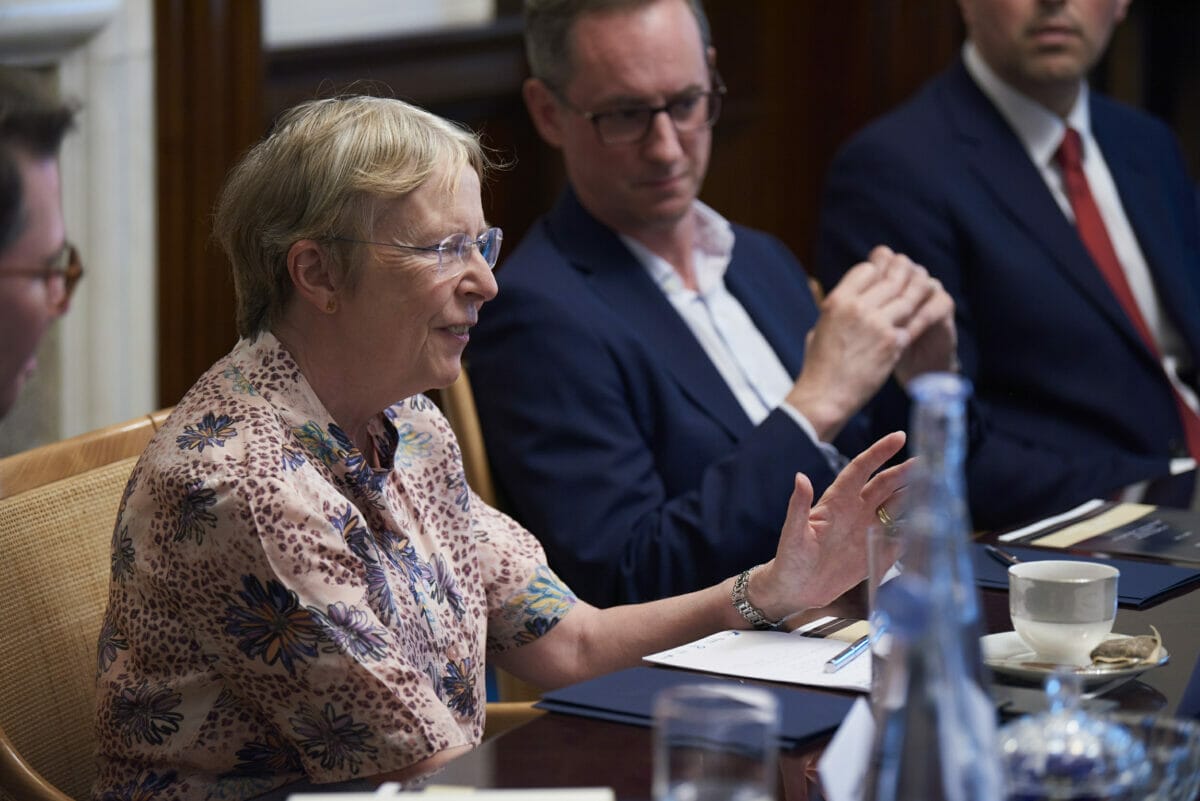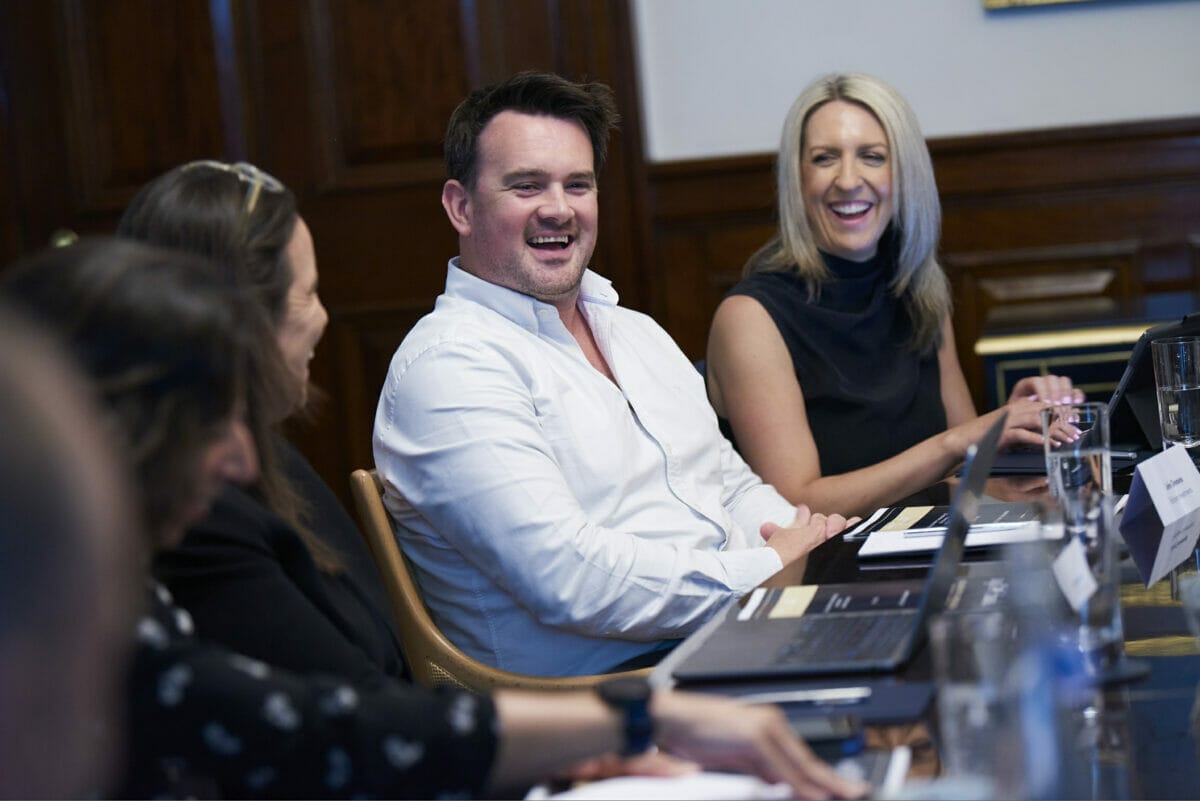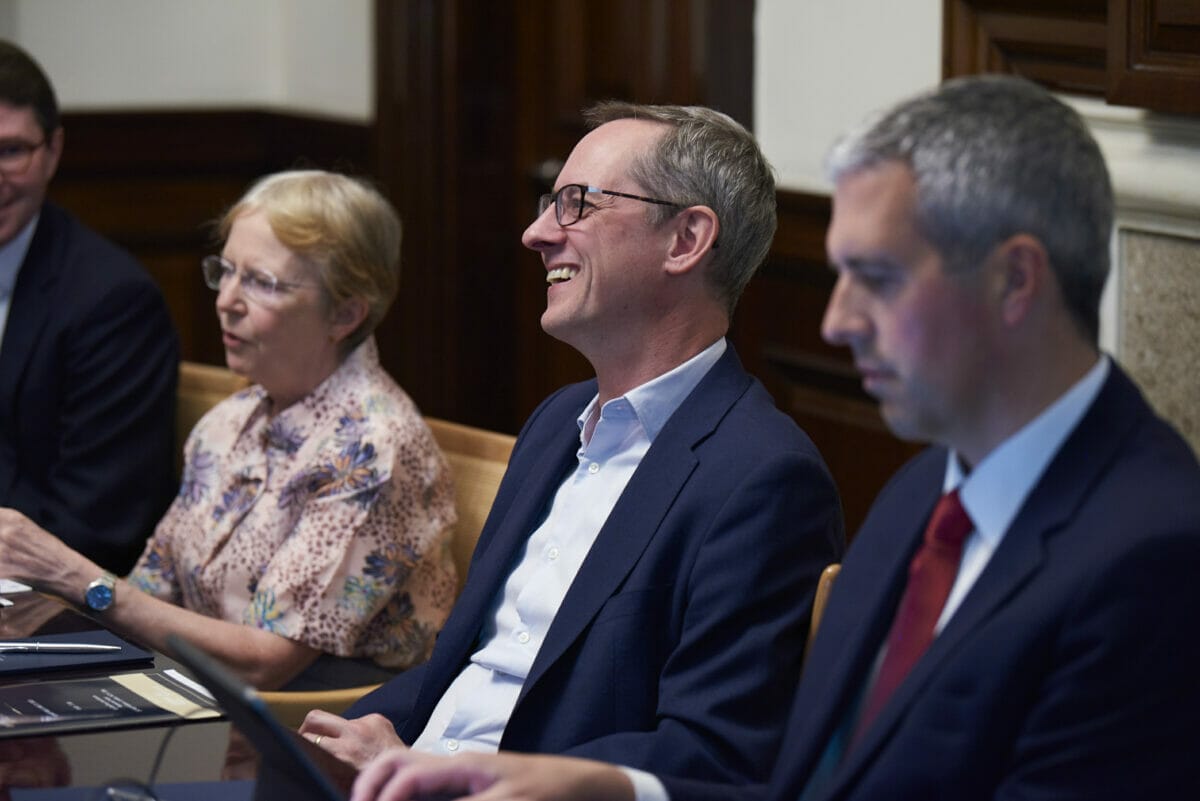As the multitude of macro-economic risks influence market conditions in unpredictable and unprecedented ways, CIOs are facing the most challenging and interesting times in their careers. A group of investors came together in London to share their ideas on how to best assess risk and position their funds for both the challenges and opportunities in this increasingly demanding and puzzling market.
Better risk and liquidity management alongside regional diversification and a bigger focus on operational excellence are key levers for portfolio resilience according to a group of large asset owners who came together in a London boardroom to share ideas. With geopolitics, liquidity concerns and a “pesky inflationary” environment on their minds, there was no shortage of topics to debate. The group focused on how the global economic pressures are impacting investment opportunities and how to position their portfolios for the best possible outcomes, no matter what the environment. Climate pressures, risk and scenario planning, and liquidity management and flexibility were key areas of sharing.
Chair of Universities Superannuation Scheme (USS) and renowned UK economist Kate Barker said inflation is still a key consideration around the strategy table. Barker, who sat on the Bank of England monetary policy committee from 2001 to 2010, said if participants didn’t remember the importance of better monetary and fiscal coordination, “we are all doomed”.
“Central banks will manage to keep inflation under control but it will be more difficult,” she said, warning that real interest rates are a lot higher than most economists estimate. “One of the things about trying to keep control of inflation is I always ask people: where do you think the neutral real interest rate is?” Barker said. “Economists still think it is zero. I don’t think that can possibly be true. We need to think that the neutral rate for the UK is about 3.5 per cent in real terms. Are we ready for that world? We are now making adjustments for that.”
Railpen head of investment strategy and research John Greaves said the fund had been wrestling with the role of bonds in a portfolio given the macro and market volatility and uncertainty. “We’ve had this pesky inflationary environment that has been difficult for investors and we’ve been looking at how to mitigate that risk in portfolios as well as take advantage of it,” he said.
In terms of portfolio resilience, the group – which also included Barclays Pension Fund chief investment officer Tony Broccardo and Norges Bank Investment Management global head of strategy research Frederik Willumsen – discussed the importance of diversification, hedging unwanted risks, organisational robustness, the sustainability of economic models and technology, liquidity, active management and dynamic asset allocation.
Is diversification still a tool for resilience?
GSAM head of UK fiduciary management Ed Francis began the discussion about diversification by asking participants to question whether diversification has delivered what it promised.
“Fundamentally we would still be of the view from an academic perspective if you can get uncorrelated sources of return working together it is better for risk management outcomes over the long term,” he said. “On the flip-side the industry has a complexity bias, and if you’re an agent in the system you do things that are more complicated. We need to control for that bias. There has been a lot of experimentation with things like alternative beta and certain areas of the credit markets and I feel like some of that hasn’t really delivered. Is there a better way?”
GSAM, which partnered Top1000funds.com on the event, recently published a paper, Investing in a high-risk world, suggesting portfolio construction in the current market environment should focus on risk management, liquidity and optimising across public and private assets simultaneously.
Railpen’s Greaves agreed that risk management needs to be a core part of any conversation around diversification.
“Everyone has different measures of risk they focus on. Principally we try to focus on the medium to long horizon with regard to risk management,” he said. “For example the relationship between emerging market debt and equity in the short term is about liquidity and risk aversion and they are highly correlated. In the long term, is whether I get paid back by Mexico related to whether Tesla has an earnings surprise? Probably not. You have to think through the medium-to long-term structural drivers of the portfolio.”
Greaves said regional diversification had probably been under-emphasised by institutional investors and would be more important going forward, as highlighted at the Fiduciary Investors Symposium in Singapore in March.
“We are entering a multi polar world. Regional diversification is a lever that many institutional investors don’t pull very hard,” he said. “A lot of western investors are pulling out of Asia, it feels like that is the wrong way around. I think that regional diversification will be much more important in the future.”
Newly appointed NEST chief investment officer Liz Fernando has been actively building out the fund’s private markets portfolio. “When we think about private markets it’s so we can get access to return streams not available in public markets and to industries and sectors which aren’t coming to public markets until later in their maturity,” Fernando said.
NEST, the £30 billion and fast-growing UK defined contribution fund, first started investing in private credit focusing on middle market lending as a complement to the high yield portfolio. It then moved into infrastructure and renewables as “an amazing opportunity to get capital in the ground and benefit from the energy transition”, Fernando said.
It’s been investing in private equity investing for about a year, with the fund now looking at natural capital, particularly timber, as the next private investment opportunity. “Natural capital is extremely uncorrelated with other asset classes and low volatility, and it fits in with our ESG goals,” she said.
The Church Commissioners for England fund was ahead of the curve in investing in natural capital with a 5 per cent allocation to forestry added to the portfolio in 2011 and producing 15 per cent per annum ever since. It also has a separate 5 per cent allocation to farmland. Church Commissioners chief investment officer Tom Joy told the roundtable his team asks two questions when considering diversification in the portfolio.
“We try to define a role an asset class should play, and then ask if it is reasonable to assume that asset class will be able to fulfil that role,” he said. “They are two different questions. We actually felt we were struggling to talk about resilience back in 2018 when the whole of fixed income, including private credit, was not offering anything like what we needed. So we started a program of building an internal dynamic hedging capability which went completely against the grain of what most people would think. We found it to be a very useful tool. We are not using it much at all now, other than removing foreign exchange hedging.”
We need to think that the neutral rate for the UK is about 3.5 per cent in real terms. Are we ready for that world?

Chris Rule has been involved in building the Local Pension Partnership from inception since becoming inaugural CIO in 2016. He’s now chief executive, and LPPI has been an important player in infrastructure in the UK as the designated manager for GLIL Infrastructure. One of the benefits of infrastructure is its cashflow, and its utility in the context of meeting the pension promise.
“We have embraced infrastructure particularly private infrastructure and harvest the income from that,” Rule said. “We look at 50 per cent of the return to come from yield.”
However, Rule said he is concerned about an emerging gap between the buyer and seller and the impact of that on capital deployment.
“What has been relatively easy to do is to deploy capital into secondary assets,” he said. “That is more challenging today because there is a big gap between seller and buyer. We have significant unallocated capital we are looking to take advantage of. Addressing the demand side of that and bringing efficiency is interesting for us. Double-digit returns and good income is positive, but capital deployment will be the question over the next few years.”
LLPI has benefited from a top down total portfolio view in its asset allocation approach which is something CPP Investments has been doing for some time and is constantly tweaking.
Managing director, public markets in the active investment management group, Romy Shioda, said the fund looks to have a strategic allocation as a collective portfolio and then considers relative value across public and private to achieve the exposures.
“We are now trying to move towards a more centralised approach and have more guidance from the top, as there are lot more correlations and macro factors that drive it. So things like inflation hedging from infrastructure is important,” she said. “We are trying to think of it at a high level and then whether we have a unique edge in public or private to invest, and the bottom-up specialty to deliver the exposures.”
But the risk with a top-down framework, according to Railpen’s Greaves, is the potential introduction of pro-cyclical behaviour.
“We have completely revamped the approach we have for managing illiquid exposures,” he said. “You’ve got to be careful chasing allocations to illiquid assets as markets are rising – particularly if you are a slightly cashflow negative fund like ours. We are telling our illiquid teams we want them to be slightly below target most of the time because we want to have dry powder if markets turn,” he says. “Investing is as much about creating the processes and frameworks to be successful through time as it is coming up with perfect SAA.”
Operational excellence
The worlds of risk, liquidity and operational excellence collided in September 2021 in the UK with the gilts crisis. GSAM’s Francis said the “LDI crisis” highlighted the impact of operational failure and inferior assessments and execution, which may have led to very poor decisions,” he said.
“There were other situations where, for structural reasons, people didn’t have visibility on their positions and had to take action as a result of that. We understand some schemes cut hedges at inopportune times. As time goes by, we are seeing more and more bad stories in the market impacting schemes’ funding levels. High-quality investment operations in that one period [were] really important, perhaps for the first time in history.”
Roundtable participants agreed that it’s not just when a liquidity event happens that operational management is important, it’s important all the time. “Operations matter even outside of a crisis,” said USS’s Barker, with GSAM head of EMEA institutional business Chloe Kipling emphasising the right governance and delegation allows for flexibility and quick decision making.
Participants agreed that investment operations within asset owners was probably under-developed compared to the investment process, with one participant noting that “everyone has a strategy until they get punched in the face”.
“If you got punched in the face last September all bets are off, it didn’t matter what great ideas you had, or new asset classes, you wouldn’t be able to do any of that good stuff because you made a fundamental mistake,” the participant said.

We are entering a multi polar world. Regional diversification is a lever that many institutional investors don’t pull very hard
Creating first-class enterprise risk frameworks is an area of improvement for asset owners, the delegates continued. The back-end and front-end systems should be brought together in a way that allows for smooth execution in the case of the escalation of a crisis.
Liquidity management is as much a discipline as picking stocks or managing a credit portfolio and should be given more priority within pension funds, the roundtable participants heard. Railpen, for example, tries to constantly think about different liquidity scenarios.
“In my experience risk systems are not great at liquidity management, they are only good as the inputs they get,” Greaves said. “With short-term liquidity management you try to model the worst scenarios for your liquidity and make sure have good coverage of those scenarios with cash-like assets, constant monitoring and nimble governance. But then it is thinking about how you top that liquidity back up and from where – the collateral ladder. That’s the more challenging bit. We try and maintain a view on sources of liquidity at all times, so we know exactly what we would do in different scenarios and it all just flows through.
“You can also engineer the strategy itself to put less strain on the liquidity of the assets and that’s a very sensible reaction to the environment we are in. But it comes at a cost to expected risk and return.”
The fundamentals of risk management and other tools used by investors may become even more relevant, but there was a belief around the table that there is a need to think more deeply about scenarios. Scenario analysis done well can give investors insights into behaviour and preferences of their stakeholders. LPPI’s Rule gave an example of a recent exercise with the fund’s investment committee.
“Scenario analysis can feel a little bit theoretical,” he said. “We wanted to give our IC something more tangible, so we did a red-team and blue-team exercise where we had our investment team gradually feed in the outcome of scenario analysis into the IC and they then discussed the information and what decisions they wanted to take.
“That was quite interesting, seeing the habits the IC developed as they started living through those scenarios, and what we saw was every single time they reached for liquidity.”
“Every time, they wanted more flexibility and agility to have a bit more liquid assets. It was interesting for the IC to live through a scenario rather than just be presented with the outcome, and it showed how they might behave differently.”
As a result of the exercise the fund has made a slight tweak and allocated a bit more into traditional fixed income. “We found in that exercise what habits the IC would form and how we could make sure we are a position to give them options they wanted in that scenario,” Rule said. “There was a tendency for them to say we want to be able to change our mind, so liquidity is important.”
Liquidity management is as much a discipline as picking stocks or managing a credit portfolio and should be given more priority within pension funds

DAA as a tool for portfolio resilience
The role of active management, and in particular dynamic asset allocation, was also on the table, with participants acknowledging that downside protection can afford a fund a bit more “budget to focus on scenarios”.
Investors at the roundtable, including CPP Investments and Barclays, focus on long term strategic asset allocation but also think about dynamic asset allocation in the context of where exposures might be impacted by negative shocks and what hedges can be put in place.
Investors were perplexed by the energy transition and whether intermediate or long-term asset allocation better deals with the disruption. Other investors such as LPPI continue to have conversations around tactical tilts, but rarely act.
“On the occasions we have done it we try to be pro-cyclical, so try to think that we have liquidity, dry powder and can take advantage,” Rule said. “We haven’t found any managers who are good at timing markets, and we know we are not. My view is that we can exert a lot of time and effort into thinking about how we can be smart, but it hasn’t really paid dividends from doing that.”
Meanwhile, Church Commissioners built a big capability for dynamic asset allocation in-house in 2018. Joy said first-line defence – things like puts and foreign exchange – is done in-house for efficient portfolio management; then a second-line defence – which is tail risk hedging – has been developed with some banks.
“The main reason we developed it inhouse is to be time-variant and counter-cyclical. We only use it when we feel really stretched and want to add defence to the portfolio,” Joy said. “It was an enormous journey to get our trustees comfortable with putting the effort into basically building a derivatives capability inhouse. It became live in 2020 and the first thing we actually did was add risk because it was the summer of 2020. But we used it a lot last year and it proved very valuable and will continue with it. The biggest change has been on the internal operation capability.”




